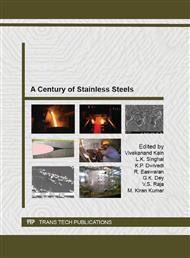p.238
p.248
p.257
p.274
p.289
p.305
p.316
p.332
p.340
Microstructure and Mechanical Properties of 16Cr-2Ni Stainless Steel Fusion and Solid State Welds-Influence of Post Weld Treatments
Abstract:
Many critical applications in chemical equipment, aircraft and ordinance demand a material of construction with high strength and good corrosion resistance. Frequently the strength requirement exceeds that obtainable with austenitic or ferritic stainless steel and it is necessary to use one of the martensitic stainless steels. Since martensitic stainless steels are structural materials, weldability has been an important consideration in their development. AISI 431 is one of the most potentially attractive steels in this class used extensively for parts requiring a combination of high tensile strength, good toughness and corrosion resistance. Although this material has been used for many years, little information is available on the welding behavior of these steels. Further, data on electron beam (EB) welding and solid state welding process like friction welding are scarce. The lack of knowledge constitutes a potential drawback to the more widespread use of these steels. Hence, a study has been taken up to develop an understanding on the electron beam welding and friction welding aspects of martensitic stainless steel type AISI 431. Various kinds of post weld heat treatments (PWHT) were investigated to determine their influence on microstructure and mechanical properties. Weld center in EB welding resulted a cast structure consists of dendritic structure with ferrite network in a matrix of un-tempered martensite. In friction welding, the weld center exhibited thermo-mechanical effected structure consists of fine intragranular acicular martensite in equiaxed prior austenite grains. In both the welding processes, post weld tempering treatment resulted in coarsening of the martensite which increases with increase in tempering temperature. In the as-weld condition, welds exhibited high strength and hardness and poor impact toughness. Increase in impact toughness and decrease in strength and hardness is observed with an increase in tempering temperature. The hardness of EB welds increased with increase in the austenitizing temperature up to 1100 °C and a marginal decrease thereafter was observed. Double austenitization after double tempering resulted in optical mechanical properties i.e., strength, hardness and toughness.
Info:
Periodical:
Pages:
289-304
Citation:
Online since:
September 2013
Authors:
Price:
Сopyright:
© 2013 Trans Tech Publications Ltd. All Rights Reserved
Share:
Citation:


